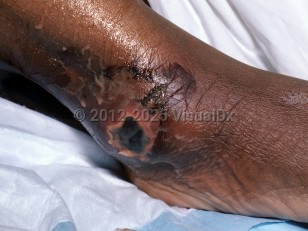Necrotizing fasciitis in Child
See also in: Cellulitis DDx,External and Internal EyeAlerts and Notices
Important News & Links
Synopsis

The mortality of necrotizing fasciitis is high. Treatment includes broad-spectrum intravenous (IV) antibiotics and immediate surgical debridement of infected and devitalized tissue. Therefore, if you are considering this diagnosis, stop reading this and contact a surgeon now.
Diagnosis Overview:
Necrotizing fasciitis is a deep and often devastating bacterial infection that tracks along fascial planes and expands well beyond any outward cutaneous signs of infection (eg, erythema). It may be classified as polymicrobial (type 1) or monomicrobial (type 2). Type 1 infections are caused by aerobic and anaerobic organisms and generally affect hosts who are immunocompromised, those with underlying illness (such as diabetes mellitus), and elderly patients. Type 2 infections are most commonly caused by Streptococcus pyogenes, although they can be caused by methicillin-resistant Staphylococcus aureus (MRSA); they can occur in healthy individuals with no past medical history.
In the pediatric population, type 2 (monomicrobial) infections are much more common than type 1 (polymicrobial) infections.
Streptococcus species, particularly S pyogenes, and MRSA are equally found to be the most common causative organisms involved in the pediatric population, followed by Pseudomonas aeruginosa. An increase in invasive S pyogenes (invasive group A strep [iGAS]) infections in children, including necrotizing fasciitis and streptococcal toxic shock syndrome, has been reported in Europe and the United States in 2022-2023.
Necrotizing fasciitis can occur without a clear portal of entry, although predisposing risk factors in the pediatric population include blunt and penetrating trauma, general infectious conditions, and breaches in the skin and mucosa (eg, lacerations, varicella vesicles, penetrating wounds, dog or insect bites, chronic skin conditions, and surgical wounds).
Patients with necrotizing fasciitis are acutely ill. They are often thought to have cellulitis that is not responding to standard antibiotic therapy. There is commonly a paucity of cutaneous findings in the early course of the disease. Pain is out of proportion to physical findings, although this may not be present in the pediatric population. There may be associated skin necrosis and bullae formation. Signs of systemic illness such as fever, lethargy, hypotension, and tachycardia are present; these may progress to multiorgan failure.
When necrotizing fasciitis is localized to the lower abdominal wall, perineum, or genitals, it is known as Fournier gangrene. Diabetic patients are particularly susceptible to Fournier gangrene, which is often polymicrobial with mixed anaerobic organisms.
Codes
M72.6 – Necrotizing fasciitis
SNOMEDCT:
52486002 – Necrotizing fasciitis
Look For
Subscription Required
Diagnostic Pearls
Subscription Required
Differential Diagnosis & Pitfalls

Subscription Required
Best Tests
Subscription Required
Management Pearls
Subscription Required
Therapy
Subscription Required
Drug Reaction Data
Subscription Required
References
Subscription Required
Last Updated:04/06/2023

